Abstract
Convalescent sera from proven cases of infection with Mycoplasma pneumoniae, and rabbit antisera to M. pneumoniae and to human erythrocyte glycoprotein contained cold hemagglutinins which were reactive only for human erythrocytes. Only the human serum cold agglutinins were inhibited by soluble integral glycoproteins derived from human erythrocyte ghosts by treatment with chloroform-methanol. Rabbit antiserum to chloroform-methanol glycoprotein, as well as to M. pneumoniae, fixed complement with either M. pneumoniae or chloroform-methanol glycoprotein antigens. The findings support the hypothesis that the cold agglutinins elicited by M. pneumoniae infection represent a cross-reaction between determinants common to erythrocyte glycoprotein containing I antigen and the membrane of M. pneumoniae.
Full text
PDF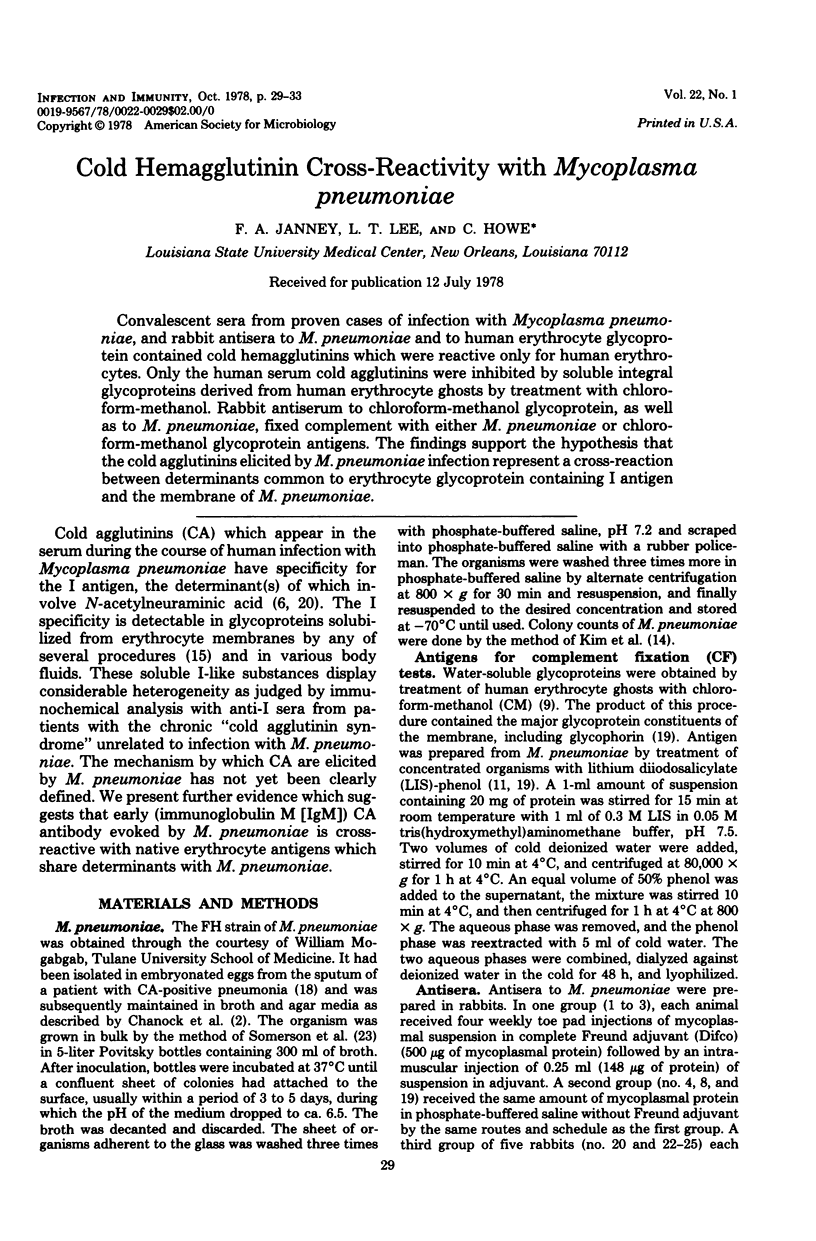
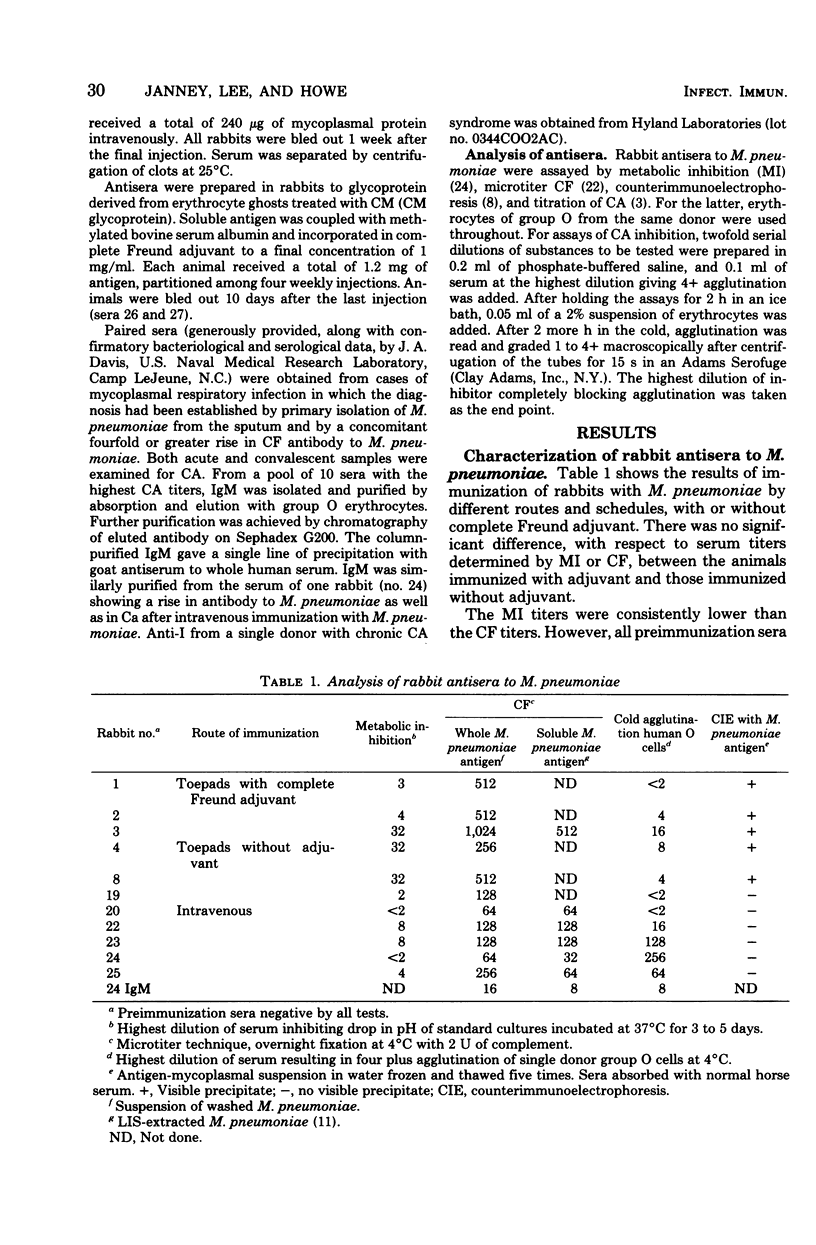
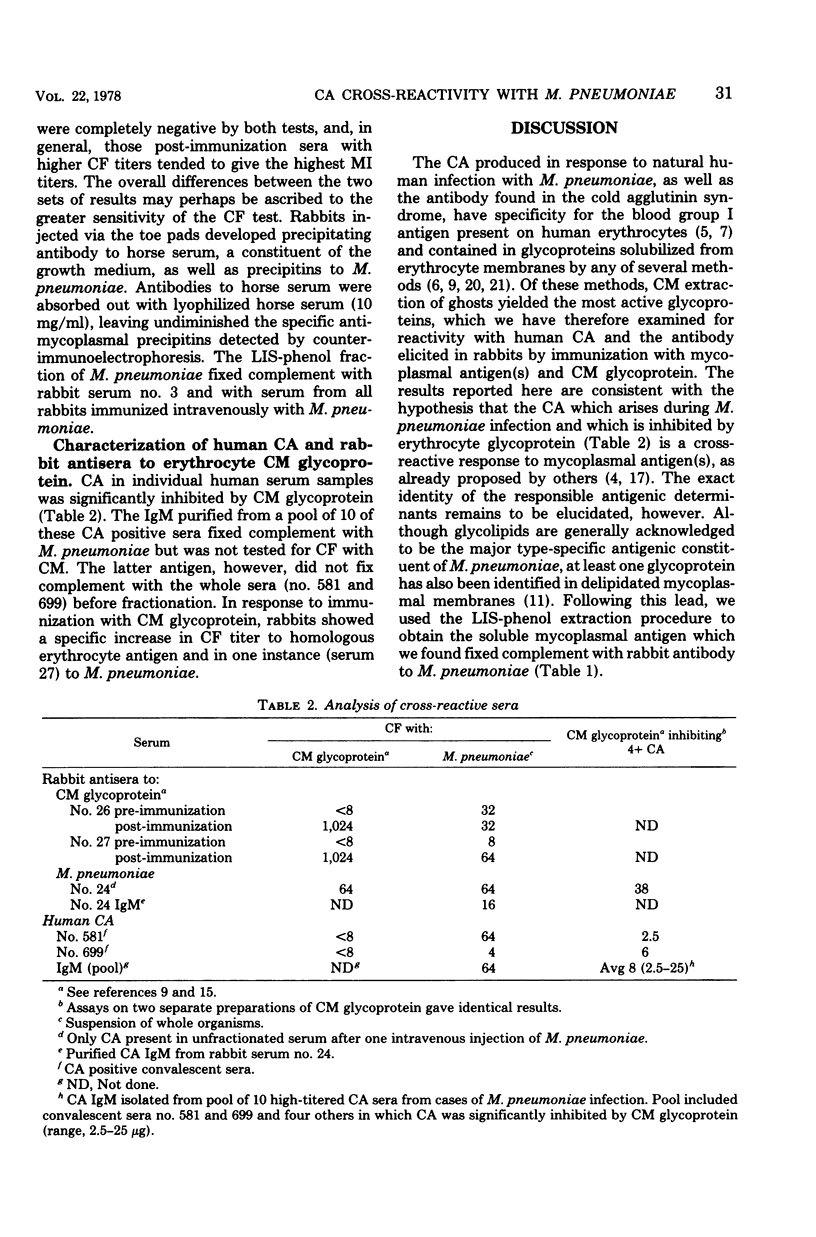
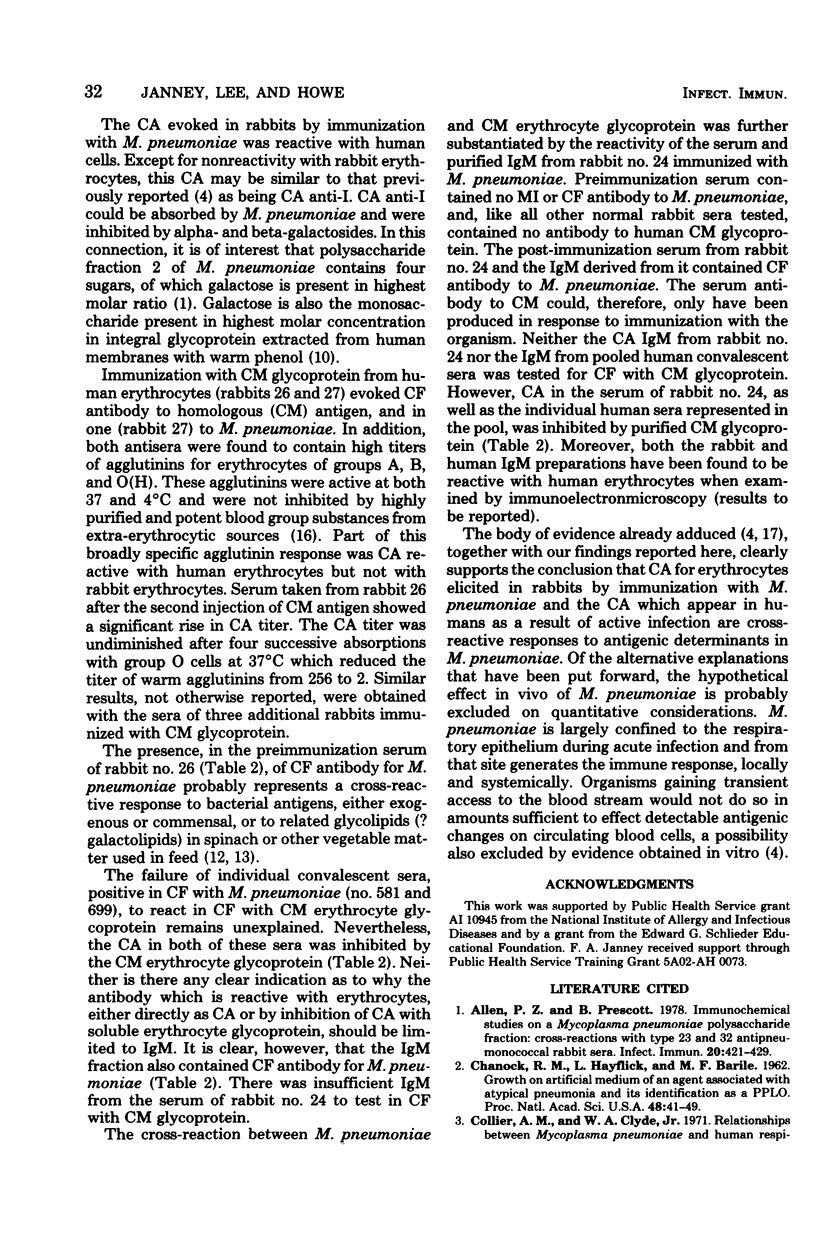
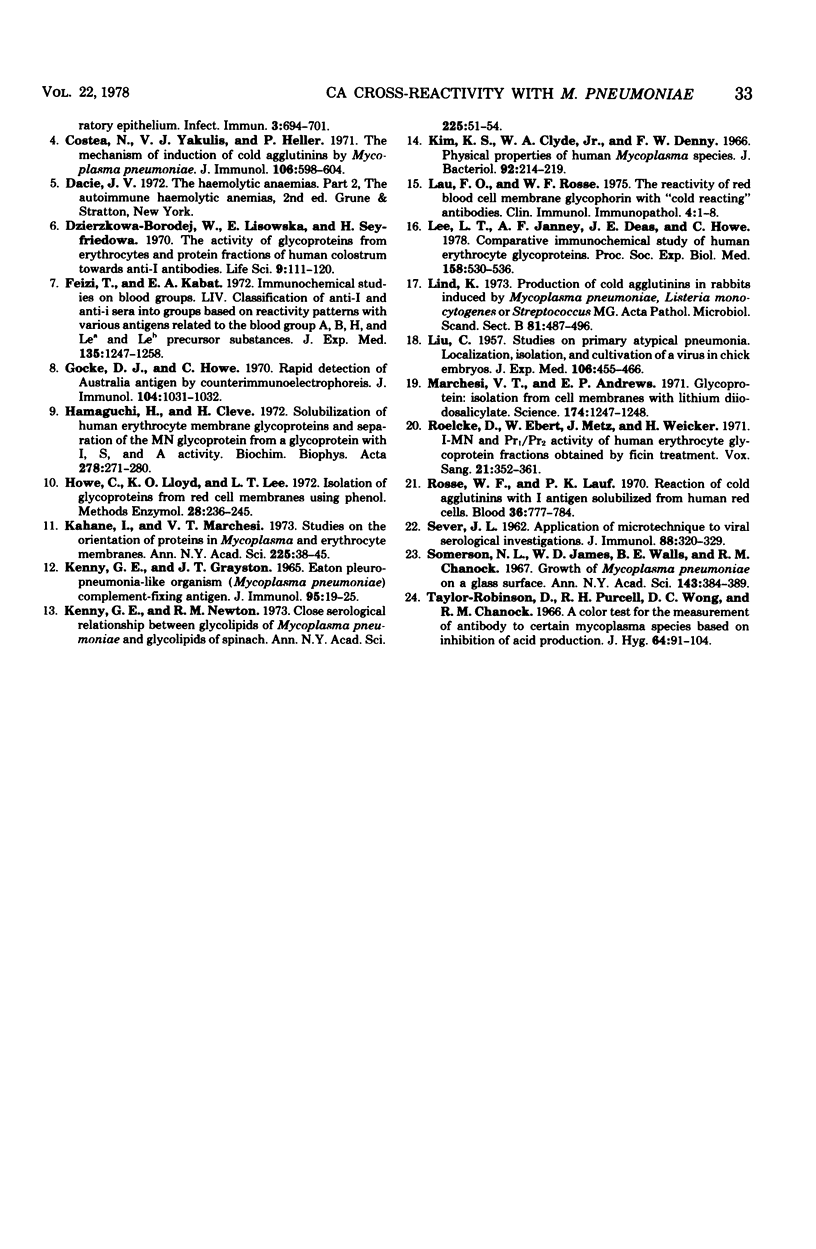
Selected References
These references are in PubMed. This may not be the complete list of references from this article.
- Allen P. Z., Prescott B. Immunochemical studies on a Mycoplasma pneumoniae polysaccharide fraction: cross-reactions with type 23 and 32 antipneumococcal rabbit sera. Infect Immun. 1978 May;20(2):421–429. doi: 10.1128/iai.20.2.421-429.1978. [DOI] [PMC free article] [PubMed] [Google Scholar]
- CHANOCK R. M., HAYFLICK L., BARILE M. F. Growth on artificial medium of an agent associated with atypical pneumonia and its identification as a PPLO. Proc Natl Acad Sci U S A. 1962 Jan 15;48:41–49. doi: 10.1073/pnas.48.1.41. [DOI] [PMC free article] [PubMed] [Google Scholar]
- Collier A. M., Clyde W. A. Relationships Between Mycoplasma pneumoniae and Human Respiratory Epithelium. Infect Immun. 1971 May;3(5):694–701. doi: 10.1128/iai.3.5.694-701.1971. [DOI] [PMC free article] [PubMed] [Google Scholar]
- Costea N., Yakulis V. J., Heller P. The mechanism of indction of cold agglutinins by mycoplasma pneumoniae. J Immunol. 1971 Mar;106(3):598–604. [PubMed] [Google Scholar]
- Dzierzkowa-Borodej W., Lisowska E., Seyfriedowa H. The activity of glycoproteins from erythrocytes and protein fractions of human colostrum towards anti-I antibodies. Life Sci. 1970 Jan 22;9(2):111–120. doi: 10.1016/0024-3205(70)90251-1. [DOI] [PubMed] [Google Scholar]
- ENNY G. E., GRAYSTON J. T. EATON PLEUROPNEUMONIA-LIKE ORGANISM (MYCOPLASMA PNEUMONIAE) COMPLEMENT-FIXING ANTIGEN: EXTRACTION WITH ORGANIC SOLVENTS. J Immunol. 1965 Jul;95:19–25. [PubMed] [Google Scholar]
- Feizi T., Kabat E. A. Immunochemical studies on blood groups. LIV. Classification of anti-I and anti-i sera into groups based on reactivity patterns with various antigens related to the blood group A,B,H, Le a, Le b and precursor substances. J Exp Med. 1972 Jun 1;135(6):1247–1258. doi: 10.1084/jem.135.6.1247. [DOI] [PMC free article] [PubMed] [Google Scholar]
- Gocke D. J., Howe C. Rapid detection of Australia antigen by counterimmunoelectrophoresis. J Immunol. 1970 Apr;104(4):1031–1034. [PubMed] [Google Scholar]
- Hamaguchi H., Cleve H. Solubilization of human erythrocyte membrane glycoproteins and separation of the MN glycoprotein from a glycoprotein with I, S, and A activity. Biochim Biophys Acta. 1972 Sep 29;278(2):271–280. doi: 10.1016/0005-2795(72)90232-2. [DOI] [PubMed] [Google Scholar]
- Kim K. S., Clyde W. A., Jr, Denny F. W. Physical properties of human Mycoplasma species. J Bacteriol. 1966 Jul;92(1):214–219. doi: 10.1128/jb.92.1.214-219.1966. [DOI] [PMC free article] [PubMed] [Google Scholar]
- LIU C. Studies on primary atypical pneumonia. I. Localization, isolation, and cultivation of a virus in chick embryos. J Exp Med. 1957 Oct 1;106(4):455–466. doi: 10.1084/jem.106.4.455. [DOI] [PMC free article] [PubMed] [Google Scholar]
- Lau F. O., Rosse W. F. The reactivity of red blood cell membrane glycophorin with "cold-reacting" antibodies. Clin Immunol Immunopathol. 1975 May;4(1):1–8. doi: 10.1016/0090-1229(75)90032-x. [DOI] [PubMed] [Google Scholar]
- Lee L. T., Janney F. A., Deas J. E., Howe C. Comparative immunochemical study of human erythrocyte glycoproteins. Proc Soc Exp Biol Med. 1978 Sep;158(4):530–536. doi: 10.3181/00379727-158-40240. [DOI] [PubMed] [Google Scholar]
- Lind K. Production of cold agglutinins in rabbits induced by Mycoplasma pneumoniae, Listeria monocytogenes or Streptococcus MG. Acta Pathol Microbiol Scand B Microbiol Immunol. 1973 Aug;81(4):487–496. doi: 10.1111/j.1699-0463.1973.tb02234.x. [DOI] [PubMed] [Google Scholar]
- Marchesi V. T., Andrews E. P. Glycoproteins: isolation from cellmembranes with lithium diiodosalicylate. Science. 1971 Dec 17;174(4015):1247–1248. doi: 10.1126/science.174.4015.1247. [DOI] [PubMed] [Google Scholar]
- Roelcke D., Ebert W., Metz J., Weicker H. I-, MN- and Pr1/Pr2-activity of human erythrocyte glycoprotein fractions obtained by ficin treatment. Vox Sang. 1971 Oct;21(4):352–361. doi: 10.1111/j.1423-0410.1971.tb04790.x. [DOI] [PubMed] [Google Scholar]
- Rosse W. F., Lauf P. K. Reaction of cold agglutinins with I antigen solubilized from human red cells. Blood. 1970 Dec;36(6):777–784. [PubMed] [Google Scholar]
- SEVER J. L. Application of a microtechnique to viral serological investigations. J Immunol. 1962 Mar;88:320–329. [PubMed] [Google Scholar]
- Somerson N. L., James W. D., Walls B. E., Chanock R. M. Growth of Mycoplasma pneumoniae on a glass surface. Ann N Y Acad Sci. 1967 Jul 28;143(1):384–389. doi: 10.1111/j.1749-6632.1967.tb27680.x. [DOI] [PubMed] [Google Scholar]
- Taylor-Robinson D., Purcell R. H., Wong D. C., Chanock R. M. A colour test for the measurement of antibody to certain mycoplasma species based upon the inhibition of acid production. J Hyg (Lond) 1966 Mar;64(1):91–104. doi: 10.1017/s0022172400040377. [DOI] [PMC free article] [PubMed] [Google Scholar]


